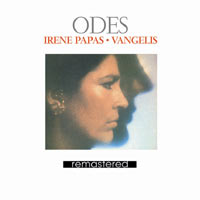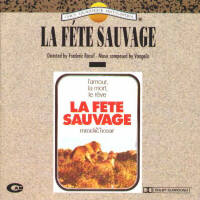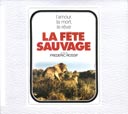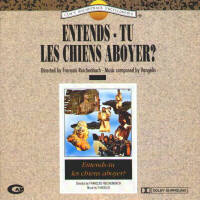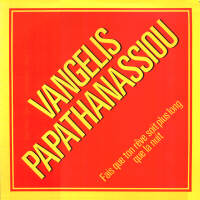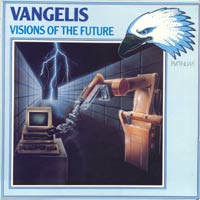Index
The album pages detail all the albums Vangelis released - including his most important collaborations - in reverse chronological order. For "best of" albums, look for the compilations section.
Odes (1979)
This album by "Irene Papas and Vangelis" consists of a collection of songs that originated from traditional vocal material dealing - in part - with the Greek resistance to the Ottoman Empire (early 19th Century and before). Vangelis and Irene Papas performed the songs in a modern way and wrote two additional new songs ("La Danse Du Feu" and "Racines"). Vangelis plays synthesizers while Papas sings the Greek lyrics.
1. Les 40 Braves 5:14
2. Neranzoula (Le Petit Oranger) 5:51
3. La Danse Du Feu 6:03
4. Les Kolokotronei 3:16
5. Le Fleuve 6:44
6. Racines 8:47
7. Lamento 8:29
8. Menousis 6:37
To learn more about the backgrounds and lyrics behind the songs on this album, read the:
 Elsewhere: Translations and notes
Elsewhere: Translations and notes
In Greece, a re-mastered edition was released in 2007, with a partly translated track list:
1. 40 Braves 5:16
2. Little Orange Tree 5:44
3. Fire Dance 6:01
4. The Kolokotronei 3:15
5. The River 6:41
6. The Roots 8:45
7. Lamento 8:25
8. Menoussis 6:36
Opera Sauvage (1979)
Another album with music for Frederic Rossif's documentary work. Opera Sauvage was a series on French television focusing on all things exotic, such as foreign cultures and wild life. The series contained a lot of ethnic music, but almost all episodes included some or much new original music by Vangelis. Contrary to most other Vangelis' soundtrack releases, the album contains actual pieces from the series, not having been re-recorded. Although it's safe to assume it was probably remixed in stereo for the album release, considering most Rossif productions were mixed in mono.
The album contains some Vangelis classics. Both "L'Enfant" and "Hymne" are favorites among fans as well as cover artists, no doubt because of their uplifting romantic melodies and rich synthesizer orchestrations.
"Hymne" is probably Vangelis' most used track at wedding ceremonies and became famous in the States during the eighties when a re-recorded version was used in a TV commercial. This also boosted the sales of "Opera Sauvage" as an album, being re-released to cash in on the melody's popularity.
In general he album has a consistent overall melodic quality. Being one of the early albums to feature Vangelis' landmark instrument, the Yamaha CS-80, the sound of this album seems to bridge Vangelis' "sound" of the 70s into that of the 80s. Jon Anderson is featured again, this time however not singing but playing the harp, on the track named "Flamant Roses".
Some prints of this album, in fact, all the common European prints as well as the Japanese mini-LP editions have been mastered with the pre-emphasis flag set. This rarely used feature is only found on a limited number of CDs, produced in the '80s. It intends to reduce noise, by over emphasizing the higher tones in the recording, and indicating to the CD player to correct that. However, some CD players and in fact, almost all computer based players cannot handle the necessary filtering, and will play back the CD with unintended harsh high tones. If you created your own mp3s of your CD, you have most likely been listening to the uncorrected master with emphasis applied. Even worse: The respective labels seem to have been unaware of this and delivered the music to iTunes, Apple Music, Spotify, etc. without applying the required filtering.
1. Hymne 2:41
2. Reve 12:27
3. L'Enfant 4:57
4. Mouettes 2:28
5. Chromatique 3:25
6. Irlande 4:43
7. Flamant Roses 11:50
Beaubourg (1978)
An expressionistic work, consisting almost exclusively of strange, unearthly sounds. Ring modulators, noise and weird LFO effects are unleashed in wide stereo spaces. The album is often referred to as anti-commercial, because of its non melodic - even consonant - nature. This caused speculation that perhaps Vangelis submitted these recordings as his final RCA album to get rid of his contract. Vangelis however spoke with great affection about this piece in several interviews and his engineer says Vangelis took it very seriously, while recording it.
"Beaubourg" takes its title from the street in Paris and with that also refers to the "Centre Pompidou" building in Paris, which functions as a center for innovative modern (mainly abstract) arts.
This CD was printed in two variations of quality. The first German pressing was poorly mastered, with a strangely fluctuating pitch, something that was hard to pick up because of the nature of the album. The flaw was however corrected in later prints. Unfortunately the Windham Hill print in the States (1997) used the early master, hence is of bad quality. Search for later European pressings if you like this kind of music.
1. Beaubourg Part 1 17:50
2. Beaubourg Part 2 20:43
Spiral (1977)
One of the great classics, this album features separated tracks (with pauses), amongst which are the memorable "To The Unknown Man", "Dervish D" and the title track "Spiral", probably being among the most famous of Vangelis' pieces... With revolutionary sounds, fast sequencing, great melodies, rich atmospheres and great performances, this album is recognizable and more accessible than its more raw predecessors.
Many of the tracks ended up being used by TV stations throughout the world, and are sometimes still being used today.
Some European editions of the single of "To The Unknown Man" featured on its B-side a track called "To the Unknown Man part 2", which was not actually used on the album.
The title track Spiral contains spectacular arpeggiator effects, with Vangelis playing along in a rather orchestral style. Ballad is slow and slightly melancholic, with the "Ding dong" singing being performed by Vangelis himself, processed electronically to accomplish this peculiar sound.
1. Spiral 6:55
2. Ballad 8:27
3. Dervish D 5:21
4. To The Unknown Man 9:01
5. 3+3 9:43
Albedo 0.39 (1976)
One of Vangelis' most famous albums. Vangelis had become a well known artist in the UK at the point and was expected to represent the future of progressive rock. Albedo's jazz-rock-fusion-meets-early-new-age approach was very hip at the time and although it may sound rather dated nowadays, still provides the surprising experience one would expect from an album that has become such a true classic.
Pulstar was released as a single in some European countries and appeared on many cover version compilations. Alpha might be even more famous and was used as back ground music in all sorts of productions, perhaps most famously in Carl Sagan's Cosmos series. Director Costa Gavras created a short film showing the Grand Canyon around an edit of "Alpha". Other parts of the album had a more rough approach, including the energetic electronic fusion pieces call Nucleogenisis 1 and 2, which were intercut with some sweeter, orchestral sounding interludes.
The captivating title track features a hypnotic voice reading astronomical data over cosmic background music. Vangelis' studio engineer Keith Spencer-Allen performed the reading thinking it was a try-out but Vangelis insisted on actually using his take for the album.
1. Pulstar 5:45
2. Free Fall 2:20
3. Mare Tranquillitatis 1:45
4. Main Sequence 8:15
5. Sword Of Orion 2:05
6. Alpha 5:45
7. Nucleogenesis (Part One) 6:15
8. Nucleogenesis (Part Two) 5:50
9. Albedo 0.39 4:30
La Fete Sauvage (1976)
This album was reportedly recorded only three months after "Heaven and Hell" in 1975. Vangelis had recorded quite a few scores for Frederic Rossif's films and series, so even though Vangelis had moved to London and build his elaborate studio here, Rossif asked him to compose the music for his latest wild-life film, released as feature length cinema production.
The music includes a lot of African chanting and drumming, performed by a number of musicians who were invited by Vangelis to perform in his studio. The rest of the music is mostly quite calm in nature. It presents a typical seventies sounds, especially the disco-like opening title piece.
This album was released on CD, but very hard to find in most countries. Beware: there was also a 1992 CD edition (on the CAM label) which divided the album in two tracks and featured the last half of "Ignacio" in stead of the first half of "La Fete Sauvage". A new release changed the order of the tracks but still got the Ignacio part wrong. CAM finally corrected their mistake with a 1992 re-release, which would currently be the best choice to buy this album, for its sound quality. For a table with all the earlier CD versions, see the (June 16 1998 update) of the latest news section on this site.
The original LP did not list any track names, nor did it have clear indexing. This is reflected on the CD versions, as they present the music in either 1 track for the entire album or 2 tracks, one for each LP side, depending on which edition you play.
The music recorded for the movie was originally mixed in mono. Some of the tracks (including the opening theme) were included in the album as they were in the film, in mono, while other tracks were partly remixed, rerecorded, or additional instruments (flutes, percussion, animal sounds) were added to result in a stereo sound scape.
In terms of mastering, the Polydor CD most closely resembles the original LP. The CAM version uses phase differences between the two channels to appear more "stereo", which may be preferred by some.
A planned re-release with an official Vangelis supervised remaster on Cherry Red's Esoteric label sadly never materialized. A new edition of the album was released as nr. 27 on the Sugar label. Indeed it is remastered, but the result is quite a disaster. The label does not shy away from the "loudness war", using limiters that noticeable mess up the louder percussion parts. The tape is played back slightly to slow. Worst of all, the sound is processed to sound more stereo, with pleasant results for the mono parts of this album, but seriously downgrading the stereo parts of the album. Perhaps the engineers listened only to the first track, concluded the album must be mono, mixed it down to one channel (or worse, perhaps they discarded one?) and worked from there. Unacceptable.
1. La Fete Sauvage 38:34
Heaven and Hell (1975)
The first recording in Vangelis his "Nemo studio" in London. Some parts were actually recorded amongst the mess the construction workers had left to use again the following day. Vangelis created a revolutionary sound within the broad concept of the title. Many choirs (the English Chamber Choir conducted by Guy Protheroe) and many synthesizers performing a very unpredictable "fusion meets classical" composition.
It contains the very first collaboration with Jon Anderson: a song named "So long ago so Clear". The album soon became a big hit in the UK charts, making it the first commercial success of Vangelis' solo career. It is particularly well known in some countries for its appearances in the TV series "Cosmos".
Two small trivia: there is a Dutch LP "De Mantel Der Liefde" which is the soundtrack to a film. This is in fact nothing else than "Heaven and Hell" since it served as stock music for that film. Furthermore the LP "Vangelis Radio Special" exists which contains part of the music with an interview.
Furthermore, in Japan a version exists, that was re-mastered with "20bit" technology. This is supposed to be of better sound quality.
1. Heaven And Hell part 1 21:58
(includes So Long Ago So Clear 4:58)
2. Heaven And Hell part 2 21:16
There are LP versions which feature the following track listing:
A: Bacchanale
Symphony To the Powers B
2nd movement
3rd movement
So Long Ago, So Clear
B: Intestinal Bat
Needles & Bones
12 o'clock
Aries
A Way
And then the Italian '82 "Remastered" re-issue of the LP:
A: a) Riff Thing
b) Heaven and Hell
c) So Long Ago, So Clear
B: a) Falcons
b) Needles
c) Friday Night
d) J.F.
e) Heavy - Aries - Heaven
Ignacio / Entends-Tu Les Chiens Aboyer (1975)
Ignacio was originally released in 1975 as "Can you hear the dogs barking?" and "Entends-tu les chiens aboyer?". (Click here for an interesting LP sleeve design) A 1977 re-release introduced the name "Ignacio", after the main character in the film).
This album represents the soundtrack to the Mexican film "No Oyes Ladrar Los Perros?" by French director Francois Reichenbach. Vangelis was sloppily credited as "Vangiles Papathalnassiou" in its titles
The film tells the story of a poor Mexican farmer from a small village who travels across the country with his son - the fatally ill Ignacio - hoping to find a doctor who can help. Intercut are the stories and fantasies the father tells Ignacio about his adulthood. A potential future, showing him as musician, leader of the village and as hopeful immigrant in a big city.
The title refers to a traditional story, which says that a long time ago, dogs were smart and could talk. If something was stolen or woman had sinned, they always knew who did it and told the victims. But dogs misbehaved themselves and as punishment they lost their ability to speak
As usual with Vangelis soundtracks, not all of the music on the album is present in the film and a number of small passages in the film contain cues not released on the album. The film also contains some traditional music heard on location.
The album consists of two recurring main themes, both rather sad but romantic. They are complemented by some very diverse passages, like a thundering (electronic) church organ, a very fast rock piece full of synthesizer solos and an abstract collage of unusual percussion. Some gentle piano playing and dreamy landscapes (typical for Vangelis) contrast the fast and darker pieces. Throughout its diversity it still manages to sound coherent.
Released on CD, first by Barclay, later re-released several times on the CAM label. The first CAM editions however mistakenly contained the first half of "La Fete Sauvage" instead of the last half of "Igancio". CAM finally corrected this problem in their final re-release in 2002. For a table describing the various CD versions and some more information about this, see the (June 16 1998 update) of the latest news section on this site.
In most countries this album is rather hard to find.
1. Entends-Tu Les Chiens Aboyer? 39:04
L'Apocalypse Des Animaux (1973)
Vangelis' first of many contributions to Frederic Rossif's wild-life series is also the oldest solo recording by Vangelis that was re-released on CD. Having been recorded in 1972 or most likely even as early as 1971, the music preceded early solo albums like Earth, even though it was only made into an album for the first time in 1973.
The music sounds exactly as it was used in the TV series, except here it has been mixed in stereo. The series contained a lot more music, most of it in the same quality as the pieces that were selected for this release. Rossif has kept selecting music from these recordings (as well as recordings for later Rossif producties) for later movies and series, including pieces not heard in the original series.
A wonderful combination of acoustic and early electronic instruments makes this album sound far ahead of its time. Acoustic and electric guitars, electric pianos, rotary effects and stretched electronic pads from modified organs and other electronic keyboards, it's all there. Vangelis experimented with anything he could get his hands on, thus creating dreamy landscapes that others could only produce years later when synthesizers started to become a common good. This can be counted amonst the first recordings in what later was called the "new age" sound.
The CD release is one of a few rare discs that use pre-emphasis as a noise reduction device, which requires special care when using on a computer: The resulting audio should be analogly filtered to return to its original tonal balance. See our notes for Opera Sauvage for more information. Also note that the music delivered by the respective labels to download and streaming services like iTunes, Apple Music, Spotify, etc fail to correct for this feature.
1. Apocalypse Des Animaux - Generique 1:25
2. La Petite Fille De La Mer 5:53
3. Le Singe Bleu 7:30
4. La Mort Du Loup 3:00
5. L'ours Musicien 1:00
6. Creation Du Monde 9:51
7. La Mer Recommencee 5:55
Earth (1973)
The "Earth" album contains a wide range of styles and feelings, as if Vangelis was trying to find his style and sound, to follow up the Aphrodite's Child successes with something more of his own. A number of progressive rock songs with experimental and fusion elements are mixed with Greek flavors, and melodies filled with romanticism, seemingly predicting the flair in Vangelis' later output.
Contributing musicians include Anargyros Koulouris and Robert Fitoussi, while Warren Shapovitch provided a narration on two songs. Note that Fitoussi - with whom Vangelis worked on other occasions as well, some results released, others not - became famous in his own right as "F. R. David" in the eighties, singing the synth pop hit "Words Don't Come Easy".
Note that Vangelis himself actually sang some background vocals for this album.
In the eighties, a special edition of the Earth LP was released in Italy called "Superstar", which included a special booklet with Italian texts and photographs.
"Earth" was for a long time out of print, not having been released on CD, resulting in a number of bootlegs circulating, especially in the French progressive rock scene. In 1996 the Greek department of Polygram finally released the work officially on CD (Vertigo 532 783-2), but only within the borders of Greece. This CD edition however sounds a bit strange, as if it came from a poor master tape. There are de-noising artefacts, and additional reverbs were added to the recording. To compare, two tracks are available on a compilation CD called "Greek Pop Classics", in better sound quality and without the manipulations.
In the late nineties, the Greek CD was also being sold in large quantities in Germany, but it has since disappeared from the market, leaving Greece as the best place to look for this CD.
A: Come on 2:09
We were all uprooted 6:48
Sunny earth 6:38
He-o 4:09
B: Ritual 2:45
Let it happen 4:20
The city 1:17
My face in the rain 4:19
Watch out 2:50
A song 3:32
Fais Que Ton Rêve Soit Plus Long Que La Nuit (1972)
This extraordinary album ("May your dreams last longer than the night") handles the left winged student-riots in Paris, 1968. The music sounds like a collage of news recordings, sound recordings, folk songs, piano themes, and indeed: a few early synthesizers used in quit a progressive way for the era. Some lyrics were taken from inscriptions on the walls during the riots.
A few years after the initial LP release with black cover a second issue was released with a stand-out orange and yellow cover, followed by a re-release of the re-release, with pink in its cover.
The indication "Poeme Symphonique de Vangelis Papathanasiou" ("Poeme symphonique" is a general term for a musical work based on a non-musical concept) is sometimes mistaken for the title of a separate work in some discographies.
A CD version of this album was never properly distributed, but for one day only a CD was sold in Greek news stands as a premium (optional extra to come with a printed publication) with the "Ta Nea" newspaper. It came with the work's intended international title: "Paris, May 1968". The quality of this release was far from optimal (transferred from vinyl) but its distribution did manage to mark the 40 year anniversary, sharing the music in a unique way with the Greek public.
For the record: any CD found in shops, inlcuding where it is combined with "Sex Power" is an illegal counterfeit / bootleg.
A. 15:32
"C'est une nuit verte
Celle des barricades
Nuit verte ou rouge ou bleue ou noire
Qu'importe mon ami
Cela importe mon ami
L'espoir de la victoire"
B. 15:25
"Le Rêve Est Réalité
Jouissez sans entraves
Vivez sans temps morts
Baisez sans carottes"
You can download a short sound clip, faisque.zip (MP3, zipped for server reasons, 300K), of "L'espoir de la Victoire".
The Dragon (1971)
The Dragon is not a true Vangelis album. It is listed here only because it was produced and sold in large numbers by the established record industry. Vangelis however was not a part of the production. He did play the music, but it was never intended for release. He never finished it, never selected, edited or named it for release on any album. The LP put together without Vangelis' consent from selections of music recorded during jam sessions in London's Marquee studio, in 1971.
Charly Records claimed it owned the rights and released it in the late seventies / early eighties, without Vangelis' permission or knowledge, to cash in on his recently achieved successes. Vangelis went to court to have the albums taken off the shelves. He either won the case or it was settled (history is vague on this since none of the directly involved parties ever spoke a lot about this in public). However, it seems that in reality no records were actually destroyed, instead the remaining copies were simply sold off more cheaply, through all the traditional distribution channels.
The music could be described as experimental fusion. The other performers where Arghiris, Michel Ripoche, Brian Odger and Mick Waller. There is no (legal or semi-legal) CD-release of this album. CDs sold in Hungary during the 90s were bootlegs.
The cover is said to depict the elder God named "Cthulhu", who sprung from the imagination of famous horror author H.P. Lovecraft.
Read producer Giorgio Gomelsky's memories on recording with Vangelis.
A: 1 The Dragon 15:08
B: 1 Stuffed Aubergine 11:33
2 Stuffed Tomato 9:28
Hypothesis (1971)
Hypothesis is not a true Vangelis album, in the sense that he never finished this music, or intended it to be released in this way. However, it was sold in large quantities in the regular distribution chain. The music released on this LP, also available with a different cover by the title "Visions of the Future", was recorded in 1971 by Vangelis and some other musicians during a jam session in the London Marquee studios. It's considered a close relative to "The Dragon", both released illegally by the same shady characters working in the industry at that time. It's release was officially withdrawn after Vangelis undertook legal actions against Charly Records (see "The Dragon"), but it seems large quantities were still sold off through the established distribution channels.
The "Hypothesis" album consists of improvisational instrumental music, with a strong experimental jazz/fusion touch. The other performers where Michel Ripoche (who later appeared on the "China" album), Brian Odger and Tony Oxley, with Rock pioneer Giorgio Gomelski producing.
There also was a German double LP called "Portrait" which contained both Hypothesis combined with the Dragon.
"Hypothesis" was never released on CD.
Read producer Giorgio Gomelsky's memories on recording with Vangelis.
A: Hypothesis part 1 12:21
B: Hypothesis part 2 16:15
Sex Power (1970)
Sex Power is the name of a soundtrack for an experimental French movie directed by Henri Chapier. It became the first release of an album under Vangelis' own name (preceded by a career in music leading groups like Aphrodite's Child and The Forminx).
The LP was released only in s mall print run in France, and even smaller in Greece, long before the public had learned Vangelis' name or considered him a potential solo artist to follow. Therefore, for many years, these LPs became very expensive collectors items, with copies changing hands for many hundreds of US dollars (and salesprices of over $1000 have been recorded).
However, a lot has happened since, however, with more copies becoming available as the internet opened up new possibilities for 2nd hand copies of the original LPs to reach their new audience. Then, at least one counterfeit LP was printed (to look as much as the original LP as possible) and sold in large numbers on eBay. Later, a reputable label re-issued an at least semi legal new print of the album, with certain licenses officially secured, although it is debatable whether that was enough to legally re-release this music. Sources close to Vangelis say that he would never approve selling this album to modern markets. Of coure, the original French LPs
Unfortunately there was never a CD version of this album. Any CDs found in some shops over time, including those containing both this album and Fais Que Ton Reve (plus some Forminx tracks) were illegal bootlegs.
The music sounds rather "early", and has dated more than for instance "L'Apocalypse Des Animaux", which must have been recorded less than a year after "Sex Power" was. The style however is much closer to the familiar Vangelis sound than the illegal (leaked) "Hypothesis" and "The Dragon" releases were.
The music was recorded on piano, acoustic guitars and other acoustic instruments, but also a number of early electronic sounds appear throughout the work. Backing vocals are uncredited, but the distinct sound and vibrato style leave little to the imagination, that must be the voice of Aphrodite's Child collaborator Demis Roussos.
The film was a mystery for a long time, never airing on TV or being released on modern audio visual media, due to its underground character and subject matter. This changed however after a restored version of the movie was shown at a film festival in Nice, and the French archival institute INA added it to its collection of online sales.
Although the movie does contain some nudity, it is not the soft pornographic movie some had speculated it to be. The movie does stay clear of mainstream film conventions, telling a very abstract story, shifting back and forth in time and leaving as much as possible open to interpretation.
The movie's director Henry Chapier has been quoted saying Vangelis recorded most or all of the music in the film in single takes, while watching the movie, much like Vangelis would do for later movie scores. In the same way the soundtrack LP release was a precursor for later releases: Many of the themes on the LP are different takes from what is included in the movie, sometimes slightly rearranged, segued into different music, etc. There is some music left in the movie that is not available on the LP, and there is music on the album that is not heard in the movie.
Around the time of its initial release, "Sex Power" was featured at the "San Sebastian" film festival in Spain.
There are track markers on the LP, but the only titles provided on sleeve or label indicate the album sides. A 7" single release however contained two cuts from the album with proper names. The A side was called "Djemilla" and can be found on the album's A side, after the first track marker. (The first track on this side lasts about 30 seconds, followed by "Djemilla"). The B side of the single is called "Third Love" and can also be found on the A side of the album: The 5th track (The music following the fourth marker).
A: 1ere partie 17:00
B: 2ieme partie 17:27
You can download a short sound clip in MP3 format (37 sec, 183KB, stereo, 22KHz, zipped for server reasons) sexpower.zip.
Note that Vangelis also scored the soundtrack for Henri Chapier's "Amore" movie in 1973. The score to Amore was not released at the time, but an LP appeared in 2015 without the approval of Vangelis, reportedly based on licenses dating back to its creation, leaving its legality shrouded in doubt. With Vangelis never approving this release, we decided not to present it as part of this album overview.


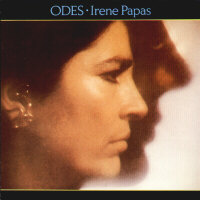 Odes
Odes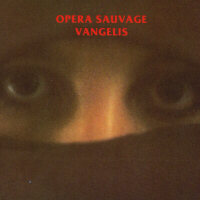 Opera Sauvage
Opera Sauvage Beaubourg
Beaubourg  Spiral
Spiral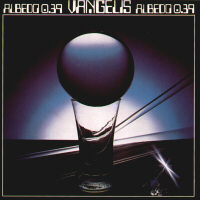 Albedo 0.39
Albedo 0.39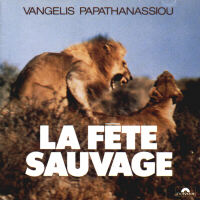 La Fete Sauvage
La Fete Sauvage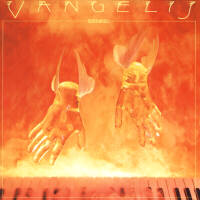 Heaven and Hell
Heaven and Hell 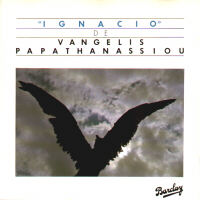 Ignacio
Ignacio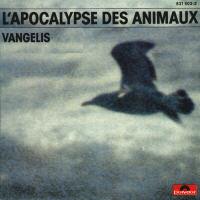 L'Apocalypse Des Animaux
L'Apocalypse Des Animaux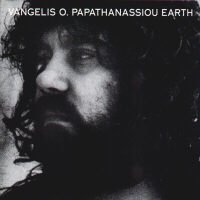 Earth
Earth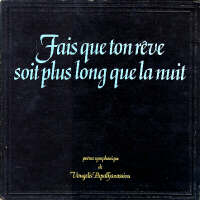 Fais Que Ton Rêve Soit …
Fais Que Ton Rêve Soit … The Dragon
The Dragon Hypothesis
Hypothesis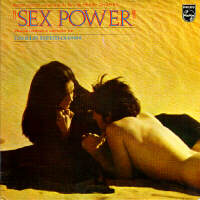 Sex Power
Sex Power